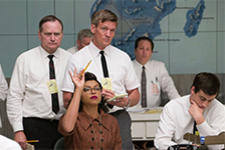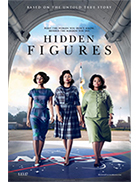Hidden Figures
|  Hidden Figures dramatizes a fascinating moment in American history, weaving together the unique political and scientific pressures of the Kennedy-era Space Race with the remaining vestiges of institutionalized racism inherent in lingering Jim Crow laws. That a country poised to blast a human being into space was still clinging to elements of discredited racial separation and discrimination is testament to the schizoid nature of how our highest aspirations can co-exist with our worst human tendencies. Hidden Figures is, first and foremost, an entertaining history lesson—a peek behind the fabled curtain of early NASA research and testing that was significantly enabled by African American women who were doubly victimized due to their race and gender. It tells a story, based on the book by Margot Lee Shetterly, that few have heard, and if it achieves a notable level of feel-good sentiment, it is because it allows us to celebrate national accomplishment in both scientific and cultural realms. Shetterly’s book has a much larger sweep than the film, covering some three decades of history, while the screenplay by Allison Schroeder and director Theodore Melfi takes a more focused approach by honing in on the time period just before and after the Soviets successfully launched Yuri Gagarin into a single orbit around the Earth on April 12, 1961, the second major victory for the USSR in the Space Race (the first being the successful launch of the satellite Sputnik 1 into orbit in 1957. Thus, the film is able to position the Americans as the underdogs, striving to catch up to Soviet achievement and prove to the world than American ingenuity, know-how, and determination are still the best in the world. As it turns out, a great deal of that ingenuity, know-how, and determination was from black women, who in many Southern states were still separated from the white co-workers—treated separately, but definitely not equally. Such was the case at the NASA research complex in Virginia where much of the work on the space program was being carried out. The film follows the various paths of three friends who work there—Katherine G. Johnson (Taraji P. Henson), Dorothy Vaughan (Octavia Spencer), and Mary Jackson (Janelle Monáe)—each of whom struggles with unique strains of racism and sexism, and yet still succeeds. Katherine is situated as the most central of the three, if only because we see glimpses of her childhood at the beginning of the film, where her incredible mathematical acumen is noticed, allowing her important pathways through the educational system. When we meet her as an adult, she is a widowed mother of three working for NASA as a “computer”—a number cruncher who works math problems and algorithms handed to her by researchers. She is elevated to working at the Space Task Group under the supervision of Al Harrison (Kevin Costner), where she helps calculate trajectories and launch windows for NASA’s earliest space launches (including those of Alan Shepherd and John Glenn, the first American to be shot into space and the first American to orbit the Earth, respectively). Yet, she is separated from her white, mostly male co-workers, given a separate (and decidedly smaller and inferior) coffee pot that she must fill herself, and treated with outright disdain by Paul Stafford (Jim Parsons), the division’s head engineer. Even worse, there is no “colored” bathroom in her building, so to relieve herself she has to trek half a mile across the NASA complex to her former building, an endeavor that is time-consuming, exhausting, and humiliating. Meanwhile, Dorothy Vaughan struggles beneath the supervision of Vivian Mitchel (Kirsten Dunst), whose supercilious treatment of her and all the other black “computers” is coated with a veneer of sweet Southern decency. “You know, despite what you think, I don’t have anything against y’all,” she tells Dorothy at one point, to which Dorothy replies, “I know. I know you probably believe that,” thus simply and eloquently identifying the vicious nature of institutionalized racism. Dorothy should have been promoted to supervisor long ago, so she circumvents the system by self-educating herself about how to use the newly installed IBM computer mainframe that no one else can manage to work. Mary Jackson, on the other hand, has aspirations to be an engineer, rather than just a “computer,” but is held back by the fact that she needs to take courses that are denied to her as both a woman and an African American. The film’s summative dialogue exchange occurs when Katherine is told that she can’t attend a meeting about John Glenn’s launch and landing for which she has provided crucial mathematical work: “There is no protocol for women attending,” Stafford tells her, to which she replies, “There is no protocol a man circling the Earth, either.” In essence, the film binds together the unknowns of the Space Race and the unknowns of true gender and racial equality, neither of which had “protocols,” but both of which were completely achievable if people were willing to drop their biases, look outside the box, and be willing to accept a brave new world. Director Theodore Melfi, in his sophomore outing following the oddball dramedy St. Vincent (2014), keeps the film running comfortably within the well-worn ruts of the uplifting historical drama, but he does it so well you can’t really fault him for not thinking more outside the box himself. He also realizes that the film’s success rides largely on the backs of its estimable cast members, and he draws excellent performances from Henson, Spencer, and Monáe, all of whom are ably supported by the likes of Kevin Costner, who embodies a sense of grim determination and near-weariness while also remaining strangely likeable, and Kirsten Dunst, who has a pinched quality that is simultaneously infuriating and a little sad. Jim Parsons has one of the trickiest roles, as he essentially embodies the larger white male culture’s distrust of both women and people of color, as he constantly underestimates Katherine’s ability to do the work put in front of her and chafes at her success, mainly because he fears that her ascension will eat into his authority. And therein lies the film’s central message about racial and gender conflict, one that is all too obviously still with us in the Trump Era: So much racism and sexism is fed not by genuine belief in the inferiority of others, but by the fear that they are, in fact, very much one’s equal and are therefore quite capable of taking one’s place. It’s sad to think that such misguided fears, which have hampered brilliant minds and crushed lives, are still in operation today, which makes Hidden Figures’ story of triumph over adversity not so much a historical lesson as it is a call to ensure that we stop making the same old mistakes. Copyright © 2017 James Kendrick Thoughts? E-mail James Kendrick All images copyright © 20th Century Fox |
Overall Rating: 


 (3.5)
(3.5)


